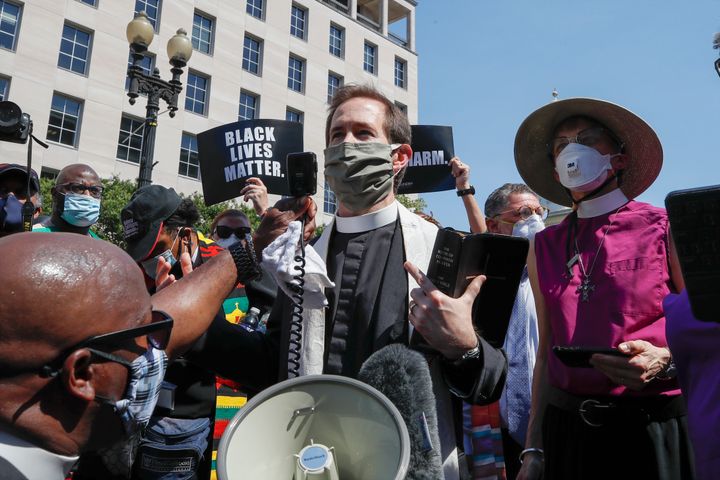[ad_1]
Federal security forces blocked clergy from having a prayer vigil in front of a Washington, D.C., church on Wednesday ― the same church that President Donald Trump freely strode up to days earlier for his photo shoot with a Bible.
More than 100 interfaith clergy answered a call from the Episcopal Diocese of Washington to gather outside St. John’s Church at Lafayette Square, directly across from the White House, for a prayer vigil on Wednesday afternoon. But an expanded security perimeter around the White House prevented the faith leaders from congregating on church property ― prompting them to scramble to find another place to meet and pray.
The change led to a truncated vigil several hundred feet away from St. John’s Church, as well as confusion and tension between the clergy and some young protesters.

Although law enforcement had opened up the street outside St. John’s Church by Thursday afternoon, Rev. Daryl Paul Lobban, an Episcopal priest who attended the vigil, told HuffPost the experience left some clergy feeling as if their First Amendment rights had been purposefully violated.
“We were very disappointed yesterday that the federal government brought in basically troops to block us from having our prayer vigil,” Lobban, the Washington diocese’s director of advocacy and justice, told HuffPost.
“There is some thought that this is a violation of our rights not only to assemble but also we were barred access, for people of faith to come together and to pray on our own property that was just used a couple days ago by the president as a photo-op,” Lobban said.
On Monday evening, Rev. Mariann Budde, the Episcopal bishop of Washington, roundly criticized Trump’s use of St. John’s Church for a photo-op as he held up a Bible. She also decried how federal law enforcement used brute force and tear gas to disperse a crowd of peaceful protesters near the church minutes before the photo shoot.
St. John’s Church had been damaged by a small fire on Sunday night as protesters nearby demanded justice for George Floyd, a Black man who was killed by a white police officer in Minneapolis last week. Despite the damage to the historic building, Budde has said it is more important to focus on the systemic racism in America that demonstrations across the country are seeking to highlight.

The Wednesday solidarity prayer vigil brought together clergy from the Episcopal Church, United Methodist Church and other Christian denominations, as well as some interfaith allies. The vigil was originally supposed to take place on the patio of St. John’s Church. The loss of that space meant that when clergy members arrived at the security barrier, they were walking right into the middle of an ongoing Black Lives Matter protest ― which meant the vigil was cut short and couldn’t take place as planned.
After several minutes of tense negotiations between clergy and protesters who were already there, the clergy led a moment of silence, followed by a prayer for justice from Bishop LaTrelle Easterling of the UMC’s Baltimore-Washington Conference.
Rev. Melanie Mullen, another D.C. Episcopal priest who attended the vigil, told the Episcopal News Service that authorities’ restrictions made it hard for some clergy to reach the vigil location.
“We have really seen what it’s like when the entire force of the government and the military and the state come out against religious freedom,” Mullen said.
A Justice Department spokesperson declined to respond to questions about why the clergy were banned from praying on St. John’s Church’s property and whether that ban violated the faith leaders’ right to religious freedom.
The spokesperson referred HuffPost to Attorney General William Barr’s Thursday press conference, in which Barr said federal law enforcement expanded the perimeter around the White House on Monday to create a “buffer zone” in response to violence on Sunday.
Barr said there was no correlation between the clearing of Lafayette Square on Monday, which he had ordered, and the president’s photo-op in front of St. John’s Church.
Lobban said he believes it’s “very problematic” when clergy are prevented from gathering to pray.
“There was no rhyme or reason why they couldn’t just give us the rest of the block to have our vigil. They stopped us right at the property line for the building,” he said. “It feels like an attempt to prevent us from having a peaceful prayer vigil.”

Now that they’ve recovered access to the patio of St. John’s Church, Lobban said that the diocese plans to continue the “ministry of presence” it had begun on Monday afternoon ― before Trump arrived on the scene ― offering water, snacks, hand sanitizer and solidarity to the protesters at Lafayette Square.
“We believe God is speaking through these young people to call for racial justice,” he said. “Our job as clergy is to respond to that call we hear from young people, mobilize and amplify their voices.”
Calling all HuffPost superfans!
Sign up for membership to become a founding member and help shape HuffPost’s next chapter
[ad_2]
Source link

